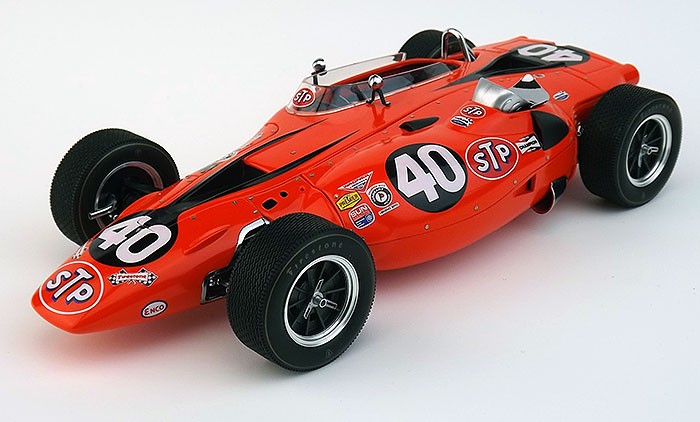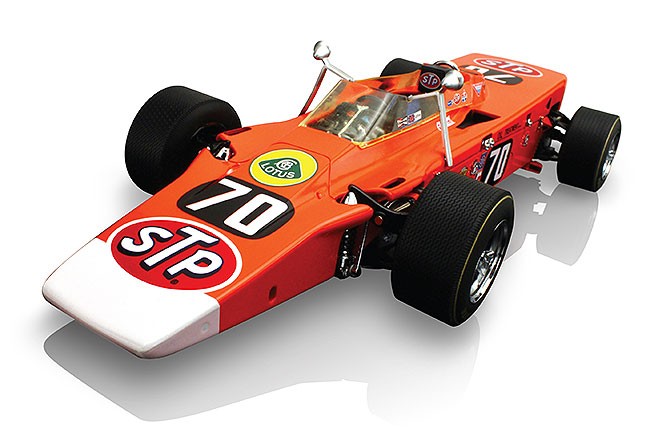Indy Turbine Cars Era
Text below from Petrolicious Article: STP Turbine Cars Were Indy Innovation At Its’ Finest
It came in 1967, and it came almost silently. When it first lined up for practice, it attracted everything from astonished stares to grandiose declarations of the future to actual threats against the team and its drivers. The STP Paxton Turbocar was radical, unlike anything the 500 had seen before or since.
Almost every part of the Turbocar was a marked departure from contemporary race cars, from the side-by-side chassis up. One the right side of its central space frame backbone was the cockpit, and on the left was a Pratt and Whitney ST6 aircraft turbine engine. The car had no transmission, instead driving power to all four wheels through a single-speed torque converter. Driving the new machine was bizarre, with driver Parnelli Jones reporting that the car would take off at idle unless the brake was held, and that the throttle would take up to three seconds to respond to input.
Because of this, other teams accused STP of sandbagging in the weeks leading up to the race. When qualifying rolled around, though, Jones was able to pilot the car to sixth on the grid. When the race began the Turbocar jumped into the lead almost immediately, and it looked like Parnelli Jones had victory well in hand until a bearing failure forced him to stop from the lead with three laps to go.
The next year, Granatelli teamed with Lotus to create the even more radical Lotus 56, and brought in Formula 1 ace Graham Hill in to drive alongside Joe Leonard and Art Pollard. The turbine moved from alongside the driver to just behind, and the wedge-shaped aerodynamic body pioneered the basic overall body shape (minus wings) that open-wheel cars would take and refine through the next decade. Despite efforts from the sanctioning body to slow the turbine cars down (restricting air intake size), Leonard took the lead early on, and again looked set to win late in the race after his teammates had dropped out, Pollard from a mechanical failure and Hill retiring after his car threw a wheel. Once again, though, the car failed just a few laps before the finish, this time from fuel pump failure, and the last great spark of Indy innovation was gone.
After 1968, the governing body at Indianapolis regulated the turbine cars into oblivion, and the Brickyard finally ceased to be the engine of racing’s creativity. But for a brief moment, Indy—and the turbine cars—looked set to change the racing world. Petrolicious Link
RepliCarz 1967 Paxton Turbine STP, Indianapolis 500, Parnelli Jones
The STP-Paxton turbine car that produced a heartbreaking near miss at the 1967 Indy 500 is the brainchild of Italian American Andy Granatelli, a racing nut who combined engineering vision with great business acumen. Granatelli had always been a speed addict, having set over 400 land speed records.
As an engineering enthusiast, having already brought Ferguson Formula four-wheel drive to Indy, Granatelli was quick to see the unfair advantage of a turbine engine matched with 4WD. Thus the STP-Paxton turbine car was born, with an FF 4WD system coupled to a reduction gear system supplied by STP’s Paxton division. It was built completely in-house by the Granatelli brothers, keeping it a secret from a competition as long as they could. As Granatelli told during an Indianapolis Legends interview in 2000: “Every single thing on the car except the wheels and the turbine engine was built in-house. Everything. And the reason we built everything in-house was because we didn’t want to go to any outside vendor to have them know that we were building a special race car. And when we built the car, it was built completely in the rules, completely in specifications.”
The model will feature a lift off side panel to show the turbine engine and all wiring, fully detailed cockpit , and a beautiful high luster paint finish with accurate race day STP markings. The nose is also removable to show chassis detail. RepliCarz
RepliCarz 1968 Lotus 56 Turbine, Indy 500, Graham Hill
This is the 1968 Lotus 56 Turbine, #70 as driven in the Indianapolis 500 by Graham Hill. TSM produced high quality replicas at a very affordable price. Features include a fully wired and plumbed engine, authentic cock pit area, and accurate decoration and high luster paint finish. These are very accurate reproductions of the historic Indy cars they represent. RepliCarz
Engines for both the 1967 STP-Paxton Turbocar and the 1968 Lotus 56 Turbocar: Variant of the Pratt & Whitney Canada PT6.
The ST6B-62 was a 550 bhp (410 kW) version of the PT6 developed for use in the STP-Paxton Turbocar, raced in the 1967 Indianapolis 500.
The STN 6/76 was a 500 bhp (370 kW) version of the PT6 developed for use in the Lotus 56, raced in the 1968 Indianapolis 500 and later in Formula One races, in 1971.
That puts both of them in the horsepower category of the PT6A-21 550 shp engine with applications to the Beechcraft King Air C90A/B/SE, Beechcraft Bonanza (turbine conversion), and Evektor EV-55 Outback. Wikipedia Link





